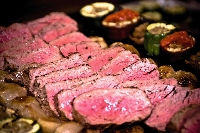
What is restaurant quality meat and how does it compare to the grocery butcher
If beef is what’s for dinner and you’re eating that dinner in a fine restaurant, you’ve probably noticed that the strip steak, ribeye or filet mignon you’re slicing tastes a lot better than the meat you bring home from the grocery store to prepare in your oven or on the grill.
Besides the fact that the restaurant’s chef probably has a culinary degree and many years of training, another reason that dinner tastes so good is because restaurants serve the highest quality of meat available. So what exactly is restaurant quality meat?
Meat products sold in the United States are inspected for safety, wholesomeness and accuracy by the Food Safety and Inspection Service, which is part of the United States Department of Agriculture, more commonly known as the USDA. This inspection of beef, pork, lamb and veal is in accordance with the Federal Meat Inspection Act to protect the public from various food borne illnesses and has nothing to do with the quality or grading of the meat. That comes from a voluntary meat grading program run by the USDA Agricultural Marketing Service. This grading is performed by trained meat graders on whole carcasses at the slaughterhouse. The symbol of that grade is the USDA shield you see on the meat itself or on boxes of steaks and packages of gourmet roasts.
For beef, the grades are based on the amount of fat or marbling in the meat and the age of the animal at the time it was slaughtered.
~
USDA Grading System
There are eight grades that can be assigned to beef: US Prime, US Choice, US Select, US Standard, US Commercial, US Utility, US Cutter and US Canner.
Utility, Cutter and Canner are used for ground meat and hot dogs and are seldom seen in stores or used by food services. Standard and Commercial grades are generally sold as ungraded and come from older animals with very little marbling, which means the cuts are not tender or juicy. The Select grade is the lowest grade you’ll normally find in a grocery store. Over 50 percent of the beef sold in stores is Choice, which comes from younger cattle and has more marbling than the lower grades.
Restaurant quality meat is graded Prime because it has the most marbling and comes from the youngest cattle, making it the tenderest and juiciest of cuts. Less than 3 percent of the beef in the US qualifies for the US Choice shield.
The grading for other types of meats is similar to beef. There are five grades for veal with Prime being the restaurant choice. Lamb is also given five grades, with Prime being the restaurant choice for its tenderness, juiciness and flavor. Poultry is given three grades and all poultry found in restaurants and stores is grade A, with grades B and C being used for foods that are further processed.
With less than 3 percent of the beef sold in the U.S. making the US Prime grade, it?s easy to see why it?s the meat you get in fine restaurants and from top-quality butcher shops and meat suppliers. When buying it in a store, remember to look for the USDA shield and not just the word ?prime.? Then take your time and enjoy the tenderness and juiciness that makes US Prime beef the choice of fine restaurants.
And don’t forget to save room for dessert!

